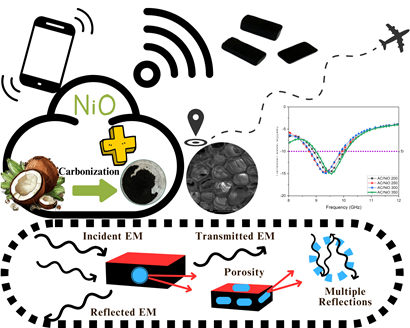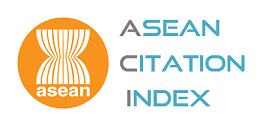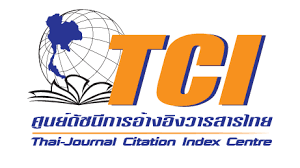Microwave absorption properties of porous activated carbon/nickel oxide composites derived from coconut husks
DOI:
https://doi.org/10.55713/jmmm.v35i3.2336Keywords:
Activated carbon, Coconut husk, MW absorber, Porous structure, Polymer compositeAbstract
Porous Activated Carbon (AC) is a promising material for microwave absorbing materials, showing potential in communication and modern warfare. The study explores the process of creating porous AC from coconut husks using hydrochloric acid and carbonization at varying temperatures, followed by doping AC with nickel oxide to create an AC/NiO polymer composite with varying thicknesses. These composites are compared to AC composites loaded in a paraffin matrix. The dielectric and microwave (MW) properties of the AC/NiO and AC polymer composites at various thicknesses were analyzed using a Performance (PNA)-X Network Analyzer. The study also examines the carbon content and porosity effect of the samples using Field Emission Scanning Electron Microscope (FESEM). The results show that the pore sizes and surface areas of the AC/NiO composites are larger than those of the AC composites. The presence of NiO enhances the dielectric and MW properties of the samples. AC and AC/NiO materials exhibit exceptional absorption more than 96%. However, AC/NiO composite carbonized at 350℃ with a thickness of 6.0 mm exhibits excellent MW absorption performance, with a minimum RL peak value of –15 dB at 6.4 GHz. Overall, this study demonstrates the great potential of a polymer composite made from coconut husk-derived AC and NiO for MW absorption.
Downloads
References
X. Xiong, H. Zhang, H. Lv, L. Yang, G. Liang, J. Zhang, Y. Lai, H-W. Cheng, and R. Che, “Recent progress in carbon-based materials and loss mechanisms for electromagnetic wave absorption,” Carbon, vol. 219, p. 118834, 2024. DOI: https://doi.org/10.1016/j.carbon.2024.118834
Z. Duan, Y. Zhang, T. Yang, Z. Lv, Y. Bai, D. Liu, and T. Peng, “Constructing core-shell biomass carbon@Fe3O4 composites for enhanced mid-to-low frequency electromagnetic wave absorption,” Materials Research Bulletin, vol. 177, p. 112853, 2024. DOI: https://doi.org/10.1016/j.materresbull.2024.112853
C. Liu, M. Han, J. Lin, W. Liu, J. Liu, and Z. Zeng, “Wood biomass-derived carbon for high-performance electromagnetic wave absorbing and shielding,” Carbon, vol. 208, pp. 255–276, 2023. DOI: https://doi.org/10.1016/j.carbon.2023.03.067
E. C. Gokce, M. D. Calisir, S. Selcuk, M. Gungor, and M. E. Acma, “Electromagnetic interference shielding using biomass-derived carbon materials,” Materials Chemistry and Physics, vol. 317, p. 129165, 2024. DOI: https://doi.org/10.1016/j.matchemphys.2024.129165
X. Yang, W. Ye, Y. Zhang, Z. Chen, Z. Zhou, K. Gao, W. Xue, and R. Zhao, “In situ loading of ZnO on hierarchical porous carbon derived from banana-peel waste to enrich mechanism for microwave absorption,” Journal of Alloys and Compounds, vol. 1003, p. 175522, 2024. DOI: https://doi.org/10.1016/j.jallcom.2024.175522
J. Zhang, L. Zhang, C. Lv, L. Gao, C. Xueqi, S. Luo, Y. Chen, Y. Ren, L. Chang, W. Guo, and Q. Tang, “Lightweight, ultra-strength, multifunctional MXene/wood composite film designed by densification strategy for electrode, thermal management, and electromagnetic shielding application,” Industrial Crops and Products, vol. 216, p. 118700, 2024. DOI: https://doi.org/10.1016/j.indcrop.2024.118700
Z.-X. Wang, X.-S. Han, Z.-J. Zhou, W.-Y. Meng, X-W. Han, S-J. Wang, and J-W. Pu, “Lightweight and elastic wood-derived composites for pressure sensing and electromagnetic interference shielding,” Composites Science and Technology, vol. 213, p. 108931, 2021. DOI: https://doi.org/10.1016/j.compscitech.2021.108931
J. Che, H. Zheng, Z. Lu, Z. Yang, Y. Gao, and Y. Wang, “Bimetallic sulfides embedded into porous carbon composites with tunable magneto-dielectric properties for lightweight biomass- reinforced microwave absorber,” Ceramics International, vol. 49, no. 16, pp. 27094–27106, 2023. DOI: https://doi.org/10.1016/j.ceramint.2023.05.254
N. Wang, K. Nan, H. Zheng, Q. Xue, W. Wang, and Y. Wang, “Two-phase magnetic nanospheres with magnetic coupling effect encapsulated in porous carbon to achieve lightweight and efficient microwave absorbers,” Journal of Colloid and Interface Science, vol. 671, pp. 56–66, 2024. DOI: https://doi.org/10.1016/j.jcis.2024.05.158
Y. Cheng, M. Chen, K. Xia, H. Li, G. Xu, L. Yang, Z. Zhao, P. Liu, and L. Wang, “Rapid conversion of biomass to hierarchical porous carbons via one-step microwave carbonization/activation for long cycle-stable supercapacitor and zinc-ion capacitor,” Journal of Power Sources, vol. 624, p. 235523, 2024. DOI: https://doi.org/10.1016/j.jpowsour.2024.235523
Anjana, and A. Chandra, “Facile synthesis and characterization of polymer composites with cobalt ferrite and biomass based activated carbon for microwave absorption,” Materials Today Communications, vol. 37, p. 107397, 2023. DOI: https://doi.org/10.1016/j.mtcomm.2023.107397
M. Wang, H. Pan, L. Xu, Y. Teng, X. Fu, Y. Zhang, M. Dou, Z. Liu, X. Huang, L. Hu, and Y. Wang, “Microwave-absorbed porous carbon was prepared from agricultural coconut shell waste by a simple one-step high temperature charring,” Materials Science and Engineering: B, vol. 307, p. 117509, 2024. DOI: https://doi.org/10.1016/j.mseb.2024.117509
G. J. H. Melvin, Z. Wang, Q. Q. Ni, N. J. Siambun, and M. M. Rahman, “Electromagnetic wave absorption properties of rice husks carbonized at 2500℃,” AIP Conference Proceedings, vol. 1091, no. 1, p. 020002, 2017. DOI: https://doi.org/10.1063/1.5010439
Z. Zulpadrianto, Y. Yohandri, and A. Putra, “Development radar absorber material using rice husk carbon for anechoic chamber application,” IOP Conference Series: Materials Science and Engineering, vol. 335, no. 1, p. 012002, 2018. DOI: https://doi.org/10.1088/1757-899X/335/1/012002
H. Soleimani, J. Y. Yusuf, H. Soleimani, L. K. Chuan, and M. Sabet, “Banana-peel derived activated carbon for microwave absorption at X-band frequency,” Synthesis and Sintering, vol. 2, no. 3, pp. 120–124, 2022. DOI: https://doi.org/10.53063/synsint.2022.2389
C. Wang, J. Li, and S. Guo, “High-performance electro-magnetic wave absorption by designing the multilayer graphene/ thermoplastic polyurethane porous composites with gradient foam ratio structure,” Composites Part A: Applied Science and Manufacturing, vol. 125, p. 105522, 2019. DOI: https://doi.org/10.1016/j.compositesa.2019.105522
Z. Wu, K. Tian, T. Huang, W. Hu, F. Xie, J. Wang, M. Su, and L. Li, “Hierarchically porous carbons derived from biomasses with excellent microwave absorption performance,” ACS Applied Materials & Interfaces, vol. 10, no. 13, pp. 11108–11115, 2018. DOI: https://doi.org/10.1021/acsami.7b17264
Y. Cheng, Z. Li, Y. Li, S. Dai, G. Ji, H. Zhao, J. Cao, and Y. Du, “Rationally regulating complex dielectric parameters of meso-porous carbon hollow spheres to carry out efficient microwave absorption,” Carbon, vol. 127, pp. 643–652, 2018. DOI: https://doi.org/10.1016/j.carbon.2017.11.055
W. Yang, L. Li, Y. Hou, Y. Liu, and X. Xiao, “Enhanced electro-magnetic wave absorption of SiOC/porous carbon composites,” Materials, vol. 15, no. 24, 2022. DOI: https://doi.org/10.3390/ma15248864
B. D. Zdravkov, J. J. Čermák, M. Šefara, and J. Janků, “Pore classification in the characterization of porous materials: A perspective,” Central European Journal of Chemistry, vol. 5, no. 2, pp. 385–395, 2007. DOI: https://doi.org/10.2478/s11532-007-0017-9
J. Y. Yusuf, H. Soleimani, N. Yahya, Y. K. Sanusi, G. Kozlowski, A. Ochsner, L. L. Adebayo, F. A. Wahaab, S. Sikiru, and B. B. Balogun, “Electromagnetic wave absorption of coconut fiber-derived porous activated carbon,” Boletin de la Sociedad Espanola de Ceramica y Vidrio, vol. 61, no. 2, pp. 417–427, 2022. DOI: https://doi.org/10.1016/j.bsecv.2021.02.003
Q. Chen, X. Liu, T. Wang, X. Su, M. Liu, S. Chaemchuen, and F. Verpoort, “A solvent-free process enabling ZnO/porous carbon with enhanced microwave absorption,” Journal of Materials Science & Technology, vol. 149, pp. 255–264, 2023. DOI: https://doi.org/10.1016/j.jmst.2022.12.034
J. Chen, G. Song, Z. Liu, L. Xie, S. Zhang, and C. Chen, “Design of core-shell nickel oxide/silicon carbide whiskers towards excellent microwave absorption property,” Chinese Journal of Chemical Engineering, vol. 37, pp. 208–216, 2021. DOI: https://doi.org/10.1016/j.cjche.2021.03.047
C. Ni, D. Wu, X. Xie, B. Wang, H. Wei, Y. Zhang, X. Zhao, L. Liu, B. Wang, and W. Du, “Microwave absorption properties of microporous CoNi@(NiO-CoO) nanoparticles through dealloying,” Journal of Magnetism and Magnetic Materials, vol. 503, p. 166631, 2020. DOI: https://doi.org/10.1016/j.jmmm.2020.166631
S. G. Danjumma, Y. Abubakar, and S. Suleiman, “Nickel oxide (NiO) devices and applications: A review,” International Journal of Engineering Research & Technology (IJERT), vol. 08, no. 04, 2019.
O. Luukkonen, S. I. Maslovski, and S. A. Tretyakov, “A stepwise Nicolson-Ross-Weir-based material parameter extraction method,” IEEE Antennas and Wireless Propagation Letters, vol. 10, pp. 1295–1298, 2011. DOI: https://doi.org/10.1109/LAWP.2011.2175897
S. Zva, and S. Znb, “Measurement of dielectric material properties application note products,” Rohde & Schwarz Benelux B.V. 2012
L. S. Rocha, C. C. Junqueira, E. Gambin, A. N. Vicente, A. E. Culhaoglu, and E. Kemptner, “A free space measurement approach for dielectric material characterization,” in SBMO/IEEE MTT-S International Microwave and Optoelectronics Conference Proceedings, 2013. DOI: https://doi.org/10.1109/IMOC.2013.6646474
Z. Liu, Y. Wang, C. Xian, K. Li, F. Wang, P. Zhang, W. Yang, S. Liu, C. Wang, H. Du, Z. Luo, J. Tang, X. Kong, L. Han, Y. Hou, and J. Yang, “High-performance microwave absorbers using a simple double-layer absorbing structure to improve impedance mismatching,” Journal of Alloys and Compounds, vol. 938, p. 168649, 2023. DOI: https://doi.org/10.1016/j.jallcom.2022.168649
W. You, and R. Che, “Excellent NiO-Ni nanoplate microwave absorber via pinning effect of antiferromagnetic-ferromagnetic interface,” ACS Applied Materials & Interfaces, vol. 10, no. 17, pp. 15104–15111, 2018. DOI: https://doi.org/10.1021/acsami.8b03610
Q. V. Thi, S. Park, J. Jeong, H. Lee, J. Hong, C. M. Koo, N. T. Tung, and D. Sohn, “A nanostructure of reduced graphene oxide and NiO/ZnO hollow spheres toward attenuation of electro-magnetic waves,” Materials Chemistry and Physics, vol. 266, p. 124530, 2021. DOI: https://doi.org/10.1016/j.matchemphys.2021.124530
A. S. Shamshirgar, M. F. Alvarez, A. d. Campo, J. F. Fernandez, R. E. R. Hernandez, R. Ivanov, J. Rosen, and I. Hussainova, “Versatile graphene-alumina nanofibers for microwave absorption and EMI shielding,” Carbon, vol. 210, p. 118057, 2023. DOI: https://doi.org/10.1016/j.carbon.2023.118057
K. Al-Badri, “Design of a perfect metamaterial absorber for microwave applications,” Basic and Applied Sciences - Scientific Journal of King Faisal University, vol. 22, no. 1, pp. 144–147, 2021 DOI: https://doi.org/10.37575/b/sci/0050
S. Chakraborty, and S. Chakraborty, “A review on the pursuit of an optimal microwave absorber,” Facta universitatis - series: Electronics and Energetics, vol. 34, no. 4, pp. 631–645, 2021. DOI: https://doi.org/10.2298/FUEE2104631C
H. Soleimani, J. Y. Yusuf, N. Yahya, A. R. Sadrolhosseini, M. Sabet, and L. A. Lanre, “Microwave absorption of coconut wasted derived activated carbon,” Fundamental and Applied Sciences, ICFAS 2020, 2021. DOI: https://doi.org/10.1007/978-981-16-4513-6_28

Downloads
Published
How to Cite
License
Copyright (c) 2025 Journal of Metals, Materials and Minerals

This work is licensed under a Creative Commons Attribution-NonCommercial-NoDerivatives 4.0 International License.
Authors who publish in this journal agree to the following terms:
- Authors retain copyright and grant the journal right of first publication with the work simultaneously licensed under a Creative Commons Attribution License that allows others to share the work with an acknowledgment of the work's authorship and initial publication in this journal.
- Authors are able to enter into separate, additional contractual arrangements for the non-exclusive distribution of the journal's published version of the work (e.g., post it to an institutional repository or publish it in a book), with an acknowledgment of its initial publication in this journal.












